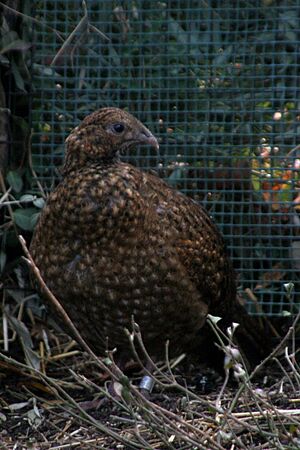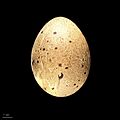Satyr tragopan facts for kids
Quick facts for kids Satyr tragopan |
|
|---|---|
 |
|
| Male | |
 |
|
| Female | |
| Conservation status | |
| Scientific classification | |
| Genus: |
Tragopan
|
| Species: |
satyra
|
| Synonyms | |
|
Meleagris satyra Linnaeus, 1758 |
|
The satyr tragopan (Tragopan satyra) is a beautiful bird also known as the crimson horned pheasant. You can find these pheasants living in the amazing Himalaya mountains. Their home stretches across parts of India, Tibet, Nepal, and Bhutan.
These birds love to live in damp forests filled with oak and rhododendron trees. They prefer places with thick bushes and bamboo patches. In summer, they live high up, between 2,400 and 4,200 meters (about 7,900 to 13,800 feet). When winter comes, they move down to around 1,800 meters (about 5,900 feet). A male satyr tragopan is usually about 70 centimeters (28 inches) long.
Contents
What Do Satyr Tragopans Look Like?
Satyr tragopans have different looks depending on if they are male or female.
Male Satyr Tragopans
Male birds are quite colorful. They are mostly red with cool blue, black, and white spots. They also have tiny freckles. During mating season, males grow bright blue horns on their heads. They also develop a special flap of skin under their chin called a gular wattle.
Female Satyr Tragopans
Female satyr tragopans are usually brown. This helps them blend in with their surroundings.
How Satyr Tragopans Find a Mate
When it's time to find a partner, male satyr tragopans put on a special show.
The Male's Display
First, the male bird will inflate his blue horns and gular wattle. This makes them look bigger and more impressive. He might hide behind a rock, waiting for a female to walk by. When a female appears, he comes out and performs an amazing dance. He stretches to his full height and shows off all his colorful feathers and ornaments. This display helps him attract a mate.
Threats to Satyr Tragopans
Even though the satyr tragopan is not the most endangered type of tragopan, it still faces some dangers.
Population and Habitat
Scientists believe there aren't many satyr tragopans left. They are hunted in many areas where they live. Also, their homes are being destroyed. This is called habitat loss. Protecting their forests is very important for these beautiful birds.
Learning About Satyr Tragopans
People have been studying satyr tragopans for a long time.
Early Discoveries
In 1750, a naturalist named George Edwards drew and described the satyr tragopan. He called it "The Horned Indian Pheasant." He used a preserved bird's head and a drawing to create his work. He thought the bird came from Bengal, but it probably came from Nepal.
Naming the Species
Later, in 1758, the famous Swedish naturalist Carl Linnaeus gave the satyr tragopan its scientific name, Meleagris satyra. He first placed it in the same group as the wild turkey. Much later, in 1829, a French naturalist named Georges Cuvier created a new group just for these birds, called Tragopan. So, the satyr tragopan's full scientific name became Tragopan satyra.
The name Tragopan comes from a Latin word for a mythical horned bird. The word satyra comes from "satyr," a Roman god often shown with horns. This name fits the male bird's unique horns!
Images for kids








